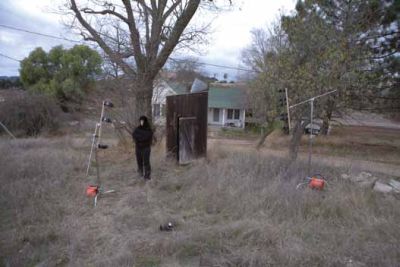articles/Lighting/shadowing-page3
Shadowing - and Other Revolutionary Ideas For Speedliting - part 3 of 1 2 3 4 5
Published 01/08/2010

Another downfall of using your Speedlite on-camera is that it throws light at everything. Think in terms of lighting your subject with your Speedlite and letting the ambient light take care of the background. In addition to moving your Speedlite off-camera, match its coverage to your subject and keep it from hitting anything else. For instance, if you are shooting a vertical headshot, then turn your Speedlite so that the head aligns with the subject.
Another feature that I use to control my Speedlite is the zoom function. The engineers who design Speedlites think that the light's coverage should match what the camera sees. So, in auto mode, the flashtube moves in and out to match the lens - from 24mm to 105mm. As I see it, by switching the zoom to manual mode I have a built-in light modifier. A tightly zoomed Speedlite creates a beautiful vignette of light.
I shoot with my Speedlites zoomed to 105mm as frequently as I shoot at all the other zoom settings combined. I hardly ever shoot with the Speedlite in auto-zoom.
Consider also that you may need to flag (block) one or both sides of the Speedlite's head so that it does not illuminate the background and/or fly into the lens. The gobo cards by HonlPhoto make quick work of stopping the spill of a Speedlite. At a pinch, your hand or a piece of cardboard will also get the job done. Where your Speedlite does not go is as important as where it does go.
Control The Ambient - You have the vision, the inspiration, and the final say. Nowhere does it say that you have to accept the ambient light as the camera wants to see it. Truth be told, the camera has no idea what it is seeing.
The camera's goal, when metering, is to think of the whole world as a shade of medium grey. To prove this, fill your camera's viewfinder with black velvet and snap a frame. The result will be a field of grey, not black, velvet. Then, fill your viewfinder with that sheet of crumpled white paper and take a shot. The result will be a similar tone of grey.
With flash photography, you control how the camera records the ambient light with the shutter speed. To dim the ambient, dial in a faster shutter speed. To brighten the ambient, use a slower shutter speed. When the camera is in manual mode, you can adjust the shutter speed directly. When the camera is in an automatic mode (Av, Tv or P), you adjust the ambient exposure by dialing in exposure compensation (EC).
One of the features I appreciate most about the Canon flash system is that I can fine-tune the ambient exposure through exposure compensation independently of the fine-tuning I create for the Speedlite through flash exposure compensation.
Please Note:
There is more than one page for this Article.
You are currently on page 3
- Shadowing - and Other Revolutionary Ideas For Speedliting page 1
- Shadowing - and Other Revolutionary Ideas For Speedliting page 2
- Shadowing - and Other Revolutionary Ideas For Speedliting page 3
- Shadowing - and Other Revolutionary Ideas For Speedliting page 4
- Shadowing - and Other Revolutionary Ideas For Speedliting page 5
1st Published 01/08/2010
last update 09/12/2022 14:58:52
More Lighting Articles
There are 18 days to get ready for The Society of Photographers Convention and Trade Show at The Novotel London West, Hammersmith ...
which starts on Wednesday 14th January 2026





